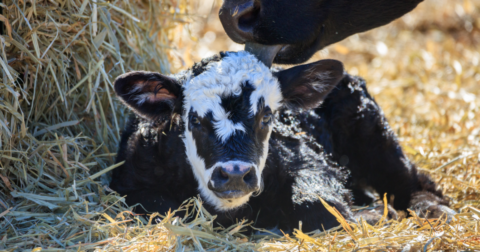News
Veganuary Hopes You’ll Resolve to Ditch Meat, at Least for One Month
Diet•4 min read
Explainer
The new ingredient is gaining in popularity — which is bad news for animal welfare.


Words by Marlena Williams
While health and beauty trends come and go, the general message often remains exactly the same: with one simple (and often costly) product, consumers can achieve an unparalleled level of wellness. These types of trends — lately products like colostrum and collagen — are proliferating at a breakneck pace, thanks to both the omnipresence of wellness influencers and the glut of advertising opportunities social media offers to both established and up-and-coming brands. One of the latest trends to rise above the online din is colostrum, a so-called “superfood” supplement that claims to ease digestive stress, boost energy and erase wrinkles, to name but a few of its purported benefits.
Colostrum companies often claim that their product is even better than collagen, another popular wellness product backed by highly-questionable science and known for its adverse impact on humans, animals and the environment.
Like collagen and many other much-hyped wellness products before it, the efficacy of colostrum is unclear, and the product raises serious ethical questions about where it comes from and how it is produced.
Colostrum is a nutrient-dense form of milk that is produced by mothers directly after giving birth. Lactating mammals like humans and cows naturally produce colostrum during and right after pregnancy. Sometimes referred to as “the first milk,” colostrum is a rich yellow in color and is thicker than regular milk. A few days after birth, colostrum transitions into mature milk, though small amounts of colostrum may remain in mature milk for several weeks. Colostrum contains a wealth of essential proteins, antibodies and vitamins that play a key role in promoting a newborn’s immunity, growth and overall health.
Though some cultures have historically used colostrum in traditional medicines or in rare culinary dishes, there has not been much commercial or pharmacological demand for colostrum for adults until fairly recently. The market for colostrum is expected to grow by about six percent in the next ten years as research into colostrum is popularized, and more companies begin selling it as a supplement or ingredient in their health and beauty products.
A quick Google search reveals that dozens of brands, from newcomers like Armra and Kion, to more established vitamin brands like NOW Foods and Swanson, have started to sell powdered bovine colostrum, which they promote as a sort of miracle product capable of revitalizing the immune system, enhancing athletic performance, improving gut health, boosting the metabolism and even diminishing the signs of aging.
Some of these companies go even further. For example, Armra — one of the most popular and heavily marketed colostrum brands — also claims its product can reactive hair follicle stem cells, reduce shedding and hair loss and combat graying. One Armra advertisement even features a user who claims that the powdered supplement transformed her graying hair into the color of caramel. Though a 2022 study out of Korea showed that colostrum could have some potential to promote hair generation in mice, the findings were not certain, and remain unsupported by human studies.

Farmers have long understood that allowing newborn calves to drink their mother’s colostrum is essential to maintaining the newborn animal’s health. Because of the extreme immunological changes that occur as a newborn animal transitions from the womb to the harsh agricultural environment, calves are at an increased risk of illness and infection after birth. Colostrum is critical to building a newborn’s immune system and protecting them from sickness and death. While allowing calves to drink their mother’s milk likely serves a commercial rather than altruistic purpose, it is considered an important and accepted part of the dairy industry.
But the recent commercialization of colostrum may disrupt or shift the incentives in this system. If colostrum becomes an increasingly profitable and in-demand product, calves and their mothers may pay the price. Though colostrum brands like Armra and Kion take pains to assure customers that “the calves’ needs always come first,” bovine colostrum is inseparable from the modern dairy industry, which is far from kind to cows or to the environment.
While female calves will often replace their mothers in the milking pipeline after the mothers are sent to slaughter, male calves are typically raised for veal and live short lives of extreme confinement, where their basic nutritional needs are left intentionally unmet. Considering this extreme disregard for the welfare of male calves, it isn’t a leap to guess that the industry might take advantage of the demand for colostrum and abuse them further.
These brands make other dubious claims as well. Armra boasts that they use only “100% pure and thoughtfully-sourced colostrum” from “family-owned” dairy farms in the United States. (Arma did not return Sentient Media’s request for comment as to what exactly “thoughtfully-sourced” means in practice.) According to the U.S Department of Agriculture, family-owned farms make up 98 percent of all farms in the United States, so being family-owned is certainly not unique, or a guarantee of quality or humane treatment.
Armra and Kion also claim that they only use overflow or surplus colostrum, which they then “upcycle.” Brands like Armra and Re-Borne claim that colostrum is widely considered a “waste product” in the dairy industry. While it is true that some mother cows do produce more colostrum than the calves technically need, colostrum is likely deemed a “waste product” because it cannot be sold as part of regular dairy milk, and because calves are often separated from their mothers before they can directly consume colostrum in the days after birth.
Statements about “upcycling” suggest that commercializing colostrum reduces farm “waste,” making it a smart and sustainable solution. But colostrum is not “waste” to a baby cow — it’s basic nutrition — and no amount of colostrum “upcycling” can make the dairy industry fundamentally environmentally sustainable.
Dairy production accounts for far more greenhouse gas emissions than plant-based dairy alternatives, and the water-intensive dairy industry has fueled drought, water scarcity and fish imperilment throughout the West.
Colostrum provides very real and important benefits to newborn humans and cows. But it is far less clear whether colostrum provides similar benefits to older children and adults.
Studies have shown that bovine colostrum may have some impact on preventing upper respiratory illnesses in athletes, modulating immune response and improving overall gut health. Other studies have also suggested that colostrum may be beneficial in helping treat COVID-19 and cancer, and may alleviate some of the symptoms associated with HIV. However, studies remain relatively limited, and some may be the products of conflicts of interest.
For example, an often-cited article on the benefits of colostrum was co-written by a member of the research and development department at PanTheryx, a Colorado-based colostrum company. In addition, Armra regularly cites a paper they funded in partnership with NIS Labs, a company that specializes in performing lab research and messaging support for commercial products.
Though more research is needed, one scientific truth remains clear: bovine colostrum has a specific purpose, and that is to bolster the immunity and overall health of vulnerable newborn calves. With its extravagant marketing promises and its dubious sourcing methods, colostrum raises serious questions about this hot new product’s impact on the newborn calves who rely on colostrum in the important days after birth.